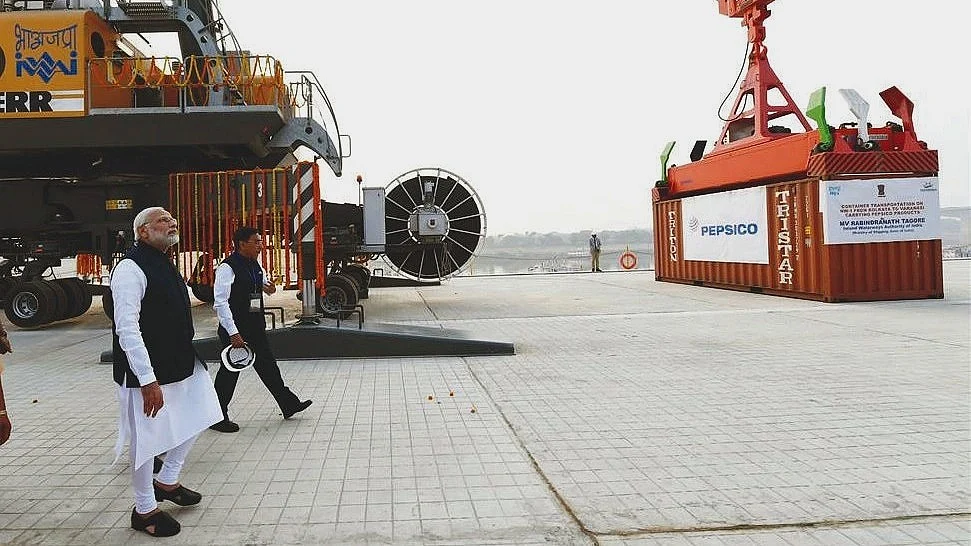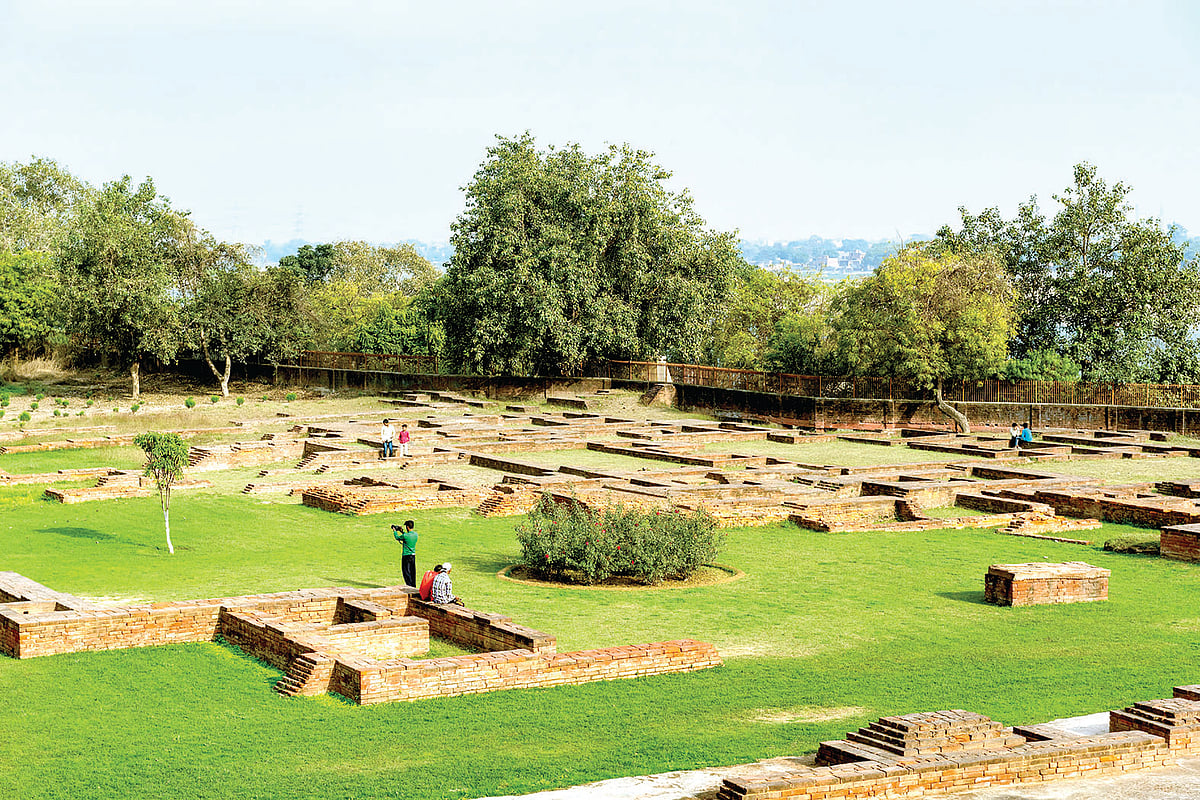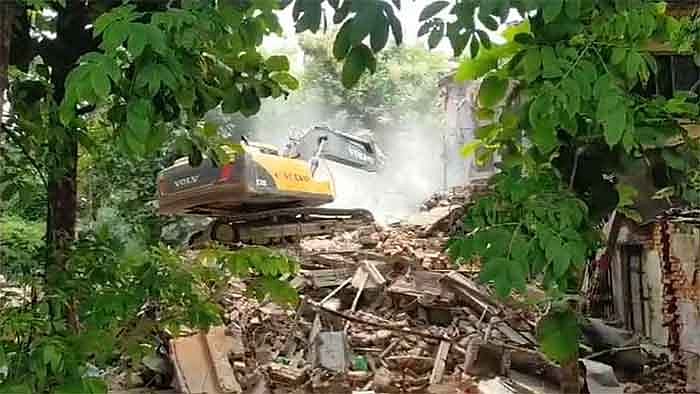The grand National Waterway and the land grab in Varanasi
To press ahead with an ill-conceived waterway project on the Ganga, the government is also ignoring environmental concerns

In November 2018, Prime Minister Narendra Modi inaugurated a multimodal terminal (MMT) on the banks of the river Ganga in Varanasi at a lavishly hosted and broadly publicised ceremony.
This terminal, it was announced, would be part of a grand National Waterway project expected to carry millions of tonnes of cargo across our key rivers. In reality, only three vessels were handled at the terminal in 2018-19 and, in 2020-21, despite a loan of Rs 1,400 crore from the World Bank, not even one.
The government has now come up with a fresh scheme for Varanasi — an inter-modal hub which will combine rail, road and river transport in a holistic manner.
As a first step, British multinational PricewaterhouseCoopers (PwC) placed a proposal for developing inter-modal stations (IMS) near Rajghat between the confluence of the Varuna and Ganga rivers. As per the Detailed Project Report (DPR) by PwC, 30.8 acres are required to develop this IMS. Where is the land to be found?
The government has got around this problem by ruthlessly acquiring 8.7 acres belonging to the Sarva Seva Sangh (SSS), an organisation that inculcates Gandhi-an values and teachings. On 12 August, a large police contingent forced its way into the SSS complex and demolished its library and a dozen other buildings.

As for making up the land-deficit of the remaining 21 acres, the government has its eyes on land belonging to the Krishnamurti Foundation. Adjacent to the SSS, this prime property falls under the jurisdiction of the Archaeological Survey of India (ASI).
Since the project site abuts the Rajghat archaeological site, which contains two historic monuments—a beautiful tomb of Lal Khan, and excavations along the lines of Sarnath undertaken by the archaeological department of the Banaras Hindu University (BHU)—the DPR has demanded that the commissioner of ASI grant them the requisite permission ‘for construction within a prohibited and protected zone’.
The DPR has also asked the National Board for Wildlife to shift the Kachhua Sanctuary located at Rajghat to another site at the earliest.
The ministry of environment and forests (MoEF) has been told to get clearance from the Allahabad High Court so that they can build within 200 metres of the Ganga’s high flood plain (HFP). The HC had passed an order that no construction be permitted on the flood plains of the Ganga and especially on the HFP. In fact, dense construction along the river banks of the Beas, Alaknanda and the Bhagirathi is one of the key causes for the massive upheaval witnessed in both Himachal and Uttarakhand during the past two months.
“PwC’s DPR shows a large part of the IMS falls within the HFP,” said Aflatoon, president of the Samajwadi Jan Parishad and an environmental activist. Chandan Pal, national president of the SSS said, “It is not correct to say that the public in Varanasi are not incensed by these developments. We conducted a 63-day satyagraha against this forcible takeover and the public supported us.”
The land on which the Rajghat Study Centre stands was acquired prior to India’s Independence from the then defence ministry. Spread over 300 acres and overlooking the Ganga, the centre runs the Rajghat Besant School and the Vasanta College for Women which has 3,000 students.
Partha Chatterjee, the registrar of the institute has expressed apprehension at the way the SSS was demolished.
“We have not received any formal notice for land acquisition from the government [and] the overall situation remains very unclear. We do not know what the present government has in mind and that is very worrisome. I am in touch with Varanasi commissioner Kaushal Raj Sharma who is overseeing all this work. What this government says and what it does are two very different things,” said Chatterjee.

Prof. P. Krishna, a physicist who headed the science department at BHU before becoming secretary of the Rajghat Study Centre is also troubled. “We have more than 5,000 students in our college and schools. Their parents are not going to take kindly to any move that will destroy the peace and tranquillity of this sacred space,” said Krishna, who is also a trustee and lives on the campus.
Staff members state that the government has in fact already listed the land for acquisition, demarcating the area from the main entrance gate up to the riverside hostel on the right and the garage on the left.
Prof. Rana P.B. Singh, a specialist in cultural landscapes and heritage studies at BHU’s department of geography is horrified at the proposed desecration. “The sacred traditions of Varanasi are being systematically destroyed by none other than the prime minister who is an MP from this constituency. It is not that the people here are not aware of what is going on but they are scared to speak out,” said Singh.
“Look at how they went about creating the Kashi Corridor. Parts of 40 temples were demolished to build this corridor, and the idols in 30 of those temples have disappeared. The ancient pilgrimage routes in and around Benaras have been destroyed. Today not even one of the 50 yatras that were cultural highpoints of this city are taking place. Scholars from BHU are not writing about these developments but scholars from the West are writing extensively on how the ethos and character of our ancient city is being destroyed.”
As Singh rightly points out, “Varanasi already has three railway stations. They [the government] could have improved any of these, or better still, improved all of them. This exercise to make another railway station is a pretext to acquire more land. A multimodal terminal was created five years ago in Varanasi, which proved to be a white elephant and is not being used at all.”
Shripad Dharmadhikary, who heads the NGO Manthan Adhyayan Kendra has been closely studying the National Inland Waterways Programme. He has raised concerns on the feasibility of these waterways, pointing out the high costs of creating and maintaining them as also the lack of cargo and passenger demand.
“If we consider the entire origin-to-destination cost, transporting cargo by road and rail is more economical than by waterways. Besides, a river must have enough depth throughout the year to be viable as a waterway. This is not the case with most of our rivers including the Ganga. If they resort to dredging, it may damage riverbed habitats and ecology,” says Dharmadhikary.
The PwC DPR however validates the project by stating that ‘the IMS will provide an interconnecting hub allowing passengers to change transportation modes in transit without leaving the station premises…. It will also provide retail and leisure experiences.’
Follow us on: Facebook, Twitter, Google News, Instagram
Join our official telegram channel (@nationalherald) and stay updated with the latest headlines
